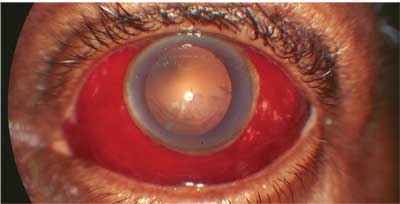
Patients who have subconjunctival hemorrhage (SCH), like patients who have eyelid myokymia (see Something for Nothing, Part I, October 15, 2006), often are quite worried when they present for an exam. To an individual who has never experienced SCH, the sight of blood in the eye can be extremely distressing. Here, well review the proper way to advise and manage these patients.
SCH Overview
SCH may be seen in any patient, regardless of age, sex or race. The condition represents trapped blood beneath the conjunctiva and results from the rupture of the small conjunctival capillaries.
Numerous conditions can induce SCH; acute ocular trauma is by far the most frequent etiology. However, other mechanical forces also can cause this type of vascular compromise.1,2
SCH may be encountered commonly following a Valsalva maneuver, which is defined as any attempted exhalation against a closed glottis or against a closed mouth and nose.3 Routine actions, such as sneezing, coughing or straining to lift a heavy object, may induce a Valsalva maneuver. Less often, a bout of vomiting, constipation or vigorous sexual activity may induce a Valsalva maneuver.
 |
| Repeated subconjunctival hemorrhage warrants further investigation. |
Rapid acceleration or deceleration (as might be encountered in an automobile accident) and abrupt changes in external pressure (e.g., barotrauma associated with scuba diving) represent other potential causes of SCH.4
Typically, the precipitating incident may seem so insignificant that the patient doesnt associate the event with SCH development. So, while there is a cause, it may not be identified. Also, remember that patients can withstand different degrees of trauma. For instance, we once saw an older woman who developed SCH from simply picking up a basket of wet laundry.
Exam and Management
Clearly, the patient history is critical to identifying the etiology of SCH. The etiology, in turn, dictates the course of the examination and management.
Patients who have SCH and present with a history of ocular trauma warrant a comprehensive ocular evaluation, complete with dilated fundus examination. This is be-cause, essentially, any blunt force that is sufficient to rupture conjunctival capillaries is potentially capable of damaging deeper ocular structures, resulting in conditions such as uveitis, hyphema, vitreous hemorrhage or even retinal detachment. Any such sight-threatening traumatic sequelae must be ad-dressed promptly and aggressively.
Cases of SCH that do not have a history of trauma require a more indepth review. Therefore, you need to ask these patients if there was a precipitating Valsalva maneuver. Also, ask if the patient noticed the SCH upon awakening. This is important because occasionally, trauma or a Valsalva event can occur during the night, though patients may not even recall it happening.
|
|
| Routine actions, such as sneezing, coughing or straining to lift a heavy object, may induce a Valsalva maneuver, which is known to cause subconjunctival hemorrhage. |
Beyond these questions, a thorough medical history is warranted. Inquire about any known vasculopathies or hematopathies. The latter includes hypertension, diabetes, anemia, bleeding disorders or chronic anticoagulation therapy, such as Coumadin (warfarin, Bristol-Meyers Squibb), heparin or aspirin, as these may be contributory.2
Because the appearance of SCH can be quite distressful, reassure these patients that it looks worse than it really is. This reassurance is cemented when we explain that there really is very little blood involved; however, because its trapped underneath the tightly apposed conjunctiva and spread out, it seems much more substantial. Sometimes, we use the analogy of a small drop of ketchup smeared beneath a sheet of Saran Wrap to help our patients better understand the nature of their condition.
Without any intervention, most cases of SCH resolve in about five to 10 days. Although there is no specific treatment for SCH, the following common sense medicine may help speed resolution:
Advise patients to limit their use of aspirin, ibuprofen and any other non-essential blood-thinning agents.
Have patients restrict vigorous activity (e.g., exercise or strenuous work) for a few days to help prevent exacerbation.
Prescribe warm compresses to be applied to the involved eye at least three times daily. While many patients are tempted to use cold compresses, such therapy is only useful in cases of allergy and/or inflammation. Heat tends to increase circulation to the area, which enhances breakdown of the clotted blood, thus hastening recovery.
Repeat SCH Occurrences
An isolated case of SCH in an otherwise healthy individual is not terribly significant. However, repeated cases may signify an underlying systemic condition. Patients who have repeat occurrences of SCH should be tested for common illnesses first, such as hypertension and diabetes. In addition, a complete blood count (CBC) can help identify various forms of anemia, leukemia, polycythemia and thrombocytopeniaall of which may manifest with recurrent SCH.5
Blood clotting factors should be checked as well. One commonly employed test for this is the prothrombin time or PT. (Note: Because there is significant variability in prothrombin reagents throughout the world, laboratories may report an International Normalized Ratio, or INR, with the PTa value that compensates PT variability, giving a repeatable and reliable indicator of clotting.) Another routinely ordered test for clotting abnormalities is the partial thromboplastin time (PTT).
Realize, too, that SCH may be a presenting sign of domestic violence, particularly in women and children.6 Be especially suspicious of bilateral SCH in younger patients or in women who have repeated SCH and contusions/lacerations of the orbit and face. Such findings warrant further investigation and the involvement of local authorities.
When considering the myriad ocular conditions you may face, SCH is typically not one of the more intimidating or challenging clinical diagnoses. However, before you dismiss it as nothing, perform a thorough history and evaluation, respect the patients concerns, and offer appropriate guidance and management. Our obligation to our patients goes well beyond just recognizing the obvious; we must also deal with the intangibles of health and life.
1. Wilson RJ. Subconjunctival hemorrhage: overview and management. J Am Optom Assoc 1986 May; 57(5):376-80.
2. Fukuyama J, Hayasaka S, Yamada K, Setogawa T. Causes of subconjunctival hemorrhage. Ophthalmologica 1990; 200(2): 63-7.
3. Wikipedia, the free encyclopedia. Valsalva maneuver. http://en.wikipedia.org/wiki/Valsalva_maneuver (Accessed September 22, 2006).
4.Curl A. Seeing red. A review of subconjunctival hemorrhage. Adv Nurse Pract 1999 Mar; 7(3):77-8.
5. Sodhi PK, Jose R. Subconjunctival hemorrhage: the first presenting clinical feature of idiopathic thrombocytopenic purpura. Jpn J Ophthalmol 2003 May-Jun;47(3):316-8.
6. Spitzer SG, Luorno J, Noel LP. Isolated subconjunctival hemorrhages in nonaccidental trauma. J AAPOS 2005 Feb;9(1):53-6.


